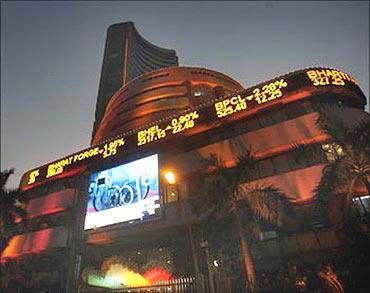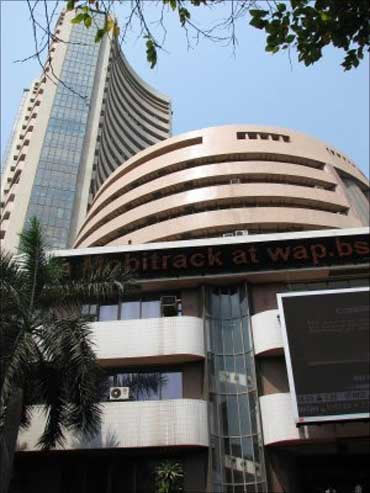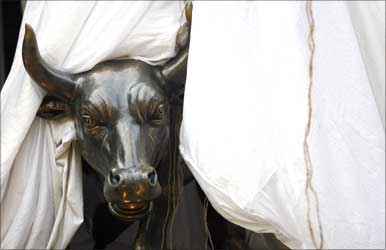 | « Back to article | Print this article |
Markets: Will it be bulls or bears?
The bulls have clearly taken control of the market, with key indices spurting over three per cent in the last two days and scaling to their 32-month highs.
The main reasons for this latest rally include strong foreign institutional investor flows, healthy Indian and Chinese manufacturing data as well as less than severe Basel-III norms.
But does the market have enough steam to keep the momentum going?
The bulls may be in charge as of now on the back of a strong domestic performance, but the weak recovery in Western economies and India's dependence on foreign flows make the domestic markets vulnerable to external shocks.
Hence, the jury is still out on which of the two sentiments will prevail. We highlight the key macroeconomic parameters to keep in mind before participating or abstaining from this rally.
Click NEXT to read further. . .
Markets: Will it be bulls or bears?
Where the bulls score: Growth story intact
A 13.8 per cent growth in industrial production was the single biggest reason for the markets' upmove and analysts expect the growth momentum to continue, given the upcoming festive season.
Although industrial growth is likely to moderate towards the end of the year due to the high base, overall growth is likely to be robust and driven by consumer goods and, to a lesser extent, capital goods.
Gross domestic product growth is also likely to be 8-8.5 per cent, driven by agriculture and industrial growth which, in turn, should result in a demand surge and benefit domestic market-focused companies.
Reforms on track
The government has scored reasonably well on long-pending reforms like gas price rationalisation, fuel price decontrol, tax reforms and relaxing of foreign direct investment in media and retail.
These are a key ingredient in ensuring faster growth, enabling such key sectors as roads, power and telecom able to get higher investments. So, expect growth to remain on track and also help bridge the fiscal deficit gap.
Click NEXT to read further. . .
Markets: Will it be bulls or bears?
Monsoon
The cumulative rainfall, which was in deficit till July (by 13 per cent), has seen a good recovery and now -- for the first week ended September -- the deficit is just 0.6 per cent below the long period average.
Better monsoon has not only improved sentiments for the Indian equity markets, but could also help in higher rural demand and lower agri-commodity prices in the near to medium term and, thus, improve demand for products and services.
Surge in FII inflows
FIIs have poured nearly Rs 64,000 crore (Rs 640 billion) into the Indian markets since January and -- given the slow economic recovery back home and the sustainable domestic story -- these are unlikely to abate in the near term.
Still, while strong flows have led to the Sensex jumping 20 per cent over the last four months, investors need to keep in mind that foreign institutional investors' flows are a double-edged sword, as was seen in the aftermath of the Lehman collapse (in 2008) and could be a source of worry if the tide turns.
Click NEXT to read further. . .
Markets: Will it be bulls or bears?
When bears may come into play
Interest rates & inflation
Backed by the strong economic growth, RBI continues to raise its key rates to curb inflation.
Since January this year, it has increased the repo rate by 50 basis points to 5.25 per cent and cash reserve ratio by 100 basis points to six per cent. This has also led to banks raising their prime lending rates by about 50 basis points to 11.75-13.25 per cent.
More important, economists expect the rates to move up further by 50-75 basis points. Increase in interest rates could emerge as a threat for the markets and corporate earnings, which are in recovery mode currently.
External trade
Among other worries, the revival in the export markets is equally important as many large companies have an overseas exposure.
However, the growth in exports is cooling down -- the growth in July was only at 13.2 per cent, the slowest in the last nine months. This is due to slower-than-expected growth in demand from developed countries.
The situation is expected to prevail as demand in international markets, particularly in the US and Europe, remains weak.
Also, the impact of withdrawal of stimulus benefits and lower demand from China has been felt on Indian exports.
Click NEXT to read further. . .
Markets: Will it be bulls or bears?
Earnings growth & valuations
The June quarter results were disappointing with aggregate results of 3,000 companies in the manufacturing sector, reporting a decline of 6.43 per cent in net profit from last year.
Some of the issues were higher commodity prices compared to last year, coupled with higher interest rates.
Analysts are now apprehensive about earnings growth over the next two-three quarters.
The Sensex is currently trading 18 times 2010-11, which is marginally higher compared to historical valuations.
In terms of valuations, Indian markets -- currently trading at 20-30 per cent higher than key global indices -- are amongst the most expensive globally. Some experts, though, justify the premium consequent to better growth rate and visibility vis--vis others.





